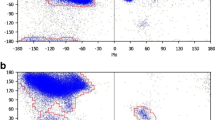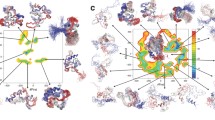Abstract
THE hydrophobic bond is the term used by Kauzmann1 to describe the gain in free energy on the transfer of non-polar residues from an aqueous environment to the interior of proteins. This has been accepted as one of the major forces involved in the folding of proteins. The exact origin of the energy of the hydrophobic bond is controversial2, but empirical values have been derived for 10 protein residue side chains by Nozaki and Tanford3 who measured the solubility of amino acids in the organic solvents ethanol and dioxane.
Similar content being viewed by others
References
Kauzmann, W., Advances in Protein Chemistry, 14, 1 (1959).
Klapper, M. H., Progress in Biorganic Chemistry, 2, 55 (1973).
Nozaki, Y., and Tanford, C., J. biol. Chem., 246, 2211 (1971).
Lee, B., and Richards, F. M., J. molec. Biol., 55, 379 (1971).
Klotz, I. M., and Franzen, J. S., J. Am. chem. Soc., 84, 3461 (1962).
Page, M. I., and Jencks, W. P., Proc. natn. Acad. Sci. U.S.A., 68, 1678 (1971).
Kauzmann, W., in The Mechanism of Enzyme Action (Johns Hopkins University Press, Baltimore, 1954).
Hermann, R. B., J. phys. Chem., Ithaca., 76, 2754 (1972).
Author information
Authors and Affiliations
Rights and permissions
About this article
Cite this article
CHOTHIA, C. Hydrophobic bonding and accessible surface area in proteins. Nature 248, 338–339 (1974). https://doi.org/10.1038/248338a0
Received:
Revised:
Published:
Issue Date:
DOI: https://doi.org/10.1038/248338a0
- Springer Nature Limited
This article is cited by
-
CSC01 shows promise as a potential inhibitor of the oncogenic G13D mutant of KRAS: an in silico approach
Amino Acids (2023)
-
Molecular dynamics simulation or structure refinement of proteins: are solvent molecules required? A case study using hen lysozyme
European Biophysics Journal (2022)
-
“Micellar catalysis on the electron transfer reactions of iron(III)-polypyridyl complexes with sulfur-containing amino acids”
Chemical Papers (2022)
-
A physics-based energy function allows the computational redesign of a PDZ domain
Scientific Reports (2020)
-
An account of solvent accessibility in protein-RNA recognition
Scientific Reports (2018)





